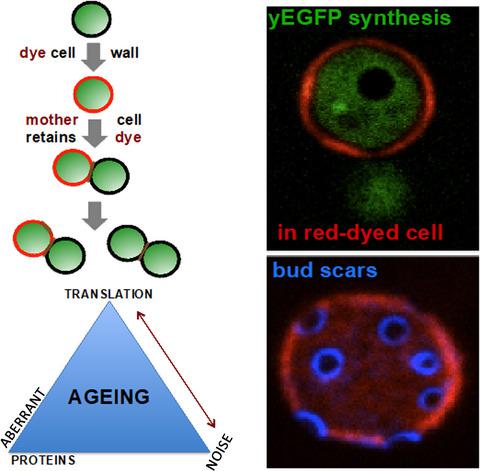Our official English website, www.x-mol.net, welcomes your
feedback! (Note: you will need to create a separate account there.)
Translational control of gene expression noise and its relationship to ageing in yeast
The FEBS Journal ( IF 5.5 ) Pub Date : 2020-10-14 , DOI: 10.1111/febs.15594 Tailise Carolina de Souza-Guerreiro 1 , Xiang Meng 1 , Estelle Dacheux 1 , Helena Firczuk 1 , John McCarthy 1
The FEBS Journal ( IF 5.5 ) Pub Date : 2020-10-14 , DOI: 10.1111/febs.15594 Tailise Carolina de Souza-Guerreiro 1 , Xiang Meng 1 , Estelle Dacheux 1 , Helena Firczuk 1 , John McCarthy 1
Affiliation

|
Gene expression noise influences organism evolution and fitness but is poorly understood. There is increasing evidence that the functional roles of components of the translation machinery influence noise intensity. In addition, modulation of the activities of at least some of these same components affects the replicative lifespan of a broad spectrum of organisms. In a novel comparative approach, we modulate the activities of the translation initiation factors eIFG1 and eIF4G2, both of which are involved in the process of recruiting ribosomal 43S preinitiation complexes to the 5’ end of eukaryotic mRNAs. We show that tagging of the cell wall using a fluorescent dye allows us to follow gene expression noise as different yeast strains progress through successive cycles of replicative ageing. This procedure reveals a relationship between global protein synthesis rate and gene expression noise (cell‐to‐cell heterogeneity), which is accompanied by a parallel correlation between gene expression noise and the replicative age of mother cells. An alternative approach, based on microfluidics, confirms the interdependence between protein synthesis rate, gene expression noise and ageing. We additionally show that it is important to characterize the influence of the design of the microfluidic device on the nutritional state of the cells during such experiments. Analysis of the noise data derived from flow cytometry and fluorescence microscopy measurements indicates that both the intrinsic and the extrinsic noise components increase as a function of ageing.
中文翻译:

酵母中基因表达噪声的翻译控制及其与衰老的关系
基因表达噪声影响生物进化和适应性,但知之甚少。越来越多的证据表明,翻译机械的组件的功能作用会影响噪声强度。此外,至少对这些相同成分中的某些成分的活性进行调节会影响多种生物体的复制寿命。在一种新颖的比较方法中,我们调节翻译起始因子eIFG1和eIF4G2的活性,这两者都参与了将核糖体43S预启动复合物募集到真核mRNA 5'末端的过程。我们显示使用荧光染料标记细胞壁使我们能够跟随基因表达的噪声,因为不同的酵母菌株通过复制性衰老的连续周期而发展。该程序揭示了总体蛋白质合成速率与基因表达噪声(细胞间异质性)之间的关系,伴随着基因表达噪声与母细胞复制年龄之间的平行相关性。一种基于微流体的替代方法,证实了蛋白质合成速率,基因表达噪声和衰老之间的相互依赖性。我们还表明,在此类实验过程中,表征微流控设备设计对细胞营养状态的影响非常重要。对流式细胞仪和荧光显微镜测量得出的噪声数据的分析表明,内在和外在的噪声成分都随着年龄的增长而增加。这伴随着基因表达噪音与母细胞复制年龄之间的平行相关性。一种基于微流体的替代方法,证实了蛋白质合成速率,基因表达噪声和衰老之间的相互依赖性。我们还表明,在此类实验过程中,表征微流控设备设计对细胞营养状态的影响非常重要。对流式细胞仪和荧光显微镜测量得出的噪声数据的分析表明,内在和外在的噪声成分都随着年龄的增长而增加。这伴随着基因表达噪音与母细胞复制年龄之间的平行相关性。一种基于微流体的替代方法,证实了蛋白质合成速率,基因表达噪声和衰老之间的相互依赖性。我们还表明,在此类实验过程中,表征微流控设备设计对细胞营养状态的影响非常重要。对流式细胞仪和荧光显微镜测量得出的噪声数据的分析表明,内在和外在的噪声成分都随着年龄的增长而增加。基因表达噪音和衰老。我们还表明,在此类实验过程中,表征微流控设备设计对细胞营养状态的影响非常重要。对流式细胞仪和荧光显微镜测量得出的噪声数据的分析表明,内在和外在的噪声成分都随着年龄的增长而增加。基因表达噪音和衰老。我们还表明,在此类实验过程中,表征微流控设备设计对细胞营养状态的影响非常重要。对流式细胞仪和荧光显微镜测量得出的噪声数据的分析表明,内在和外在的噪声成分都随着年龄的增长而增加。
更新日期:2020-10-14
中文翻译:

酵母中基因表达噪声的翻译控制及其与衰老的关系
基因表达噪声影响生物进化和适应性,但知之甚少。越来越多的证据表明,翻译机械的组件的功能作用会影响噪声强度。此外,至少对这些相同成分中的某些成分的活性进行调节会影响多种生物体的复制寿命。在一种新颖的比较方法中,我们调节翻译起始因子eIFG1和eIF4G2的活性,这两者都参与了将核糖体43S预启动复合物募集到真核mRNA 5'末端的过程。我们显示使用荧光染料标记细胞壁使我们能够跟随基因表达的噪声,因为不同的酵母菌株通过复制性衰老的连续周期而发展。该程序揭示了总体蛋白质合成速率与基因表达噪声(细胞间异质性)之间的关系,伴随着基因表达噪声与母细胞复制年龄之间的平行相关性。一种基于微流体的替代方法,证实了蛋白质合成速率,基因表达噪声和衰老之间的相互依赖性。我们还表明,在此类实验过程中,表征微流控设备设计对细胞营养状态的影响非常重要。对流式细胞仪和荧光显微镜测量得出的噪声数据的分析表明,内在和外在的噪声成分都随着年龄的增长而增加。这伴随着基因表达噪音与母细胞复制年龄之间的平行相关性。一种基于微流体的替代方法,证实了蛋白质合成速率,基因表达噪声和衰老之间的相互依赖性。我们还表明,在此类实验过程中,表征微流控设备设计对细胞营养状态的影响非常重要。对流式细胞仪和荧光显微镜测量得出的噪声数据的分析表明,内在和外在的噪声成分都随着年龄的增长而增加。这伴随着基因表达噪音与母细胞复制年龄之间的平行相关性。一种基于微流体的替代方法,证实了蛋白质合成速率,基因表达噪声和衰老之间的相互依赖性。我们还表明,在此类实验过程中,表征微流控设备设计对细胞营养状态的影响非常重要。对流式细胞仪和荧光显微镜测量得出的噪声数据的分析表明,内在和外在的噪声成分都随着年龄的增长而增加。基因表达噪音和衰老。我们还表明,在此类实验过程中,表征微流控设备设计对细胞营养状态的影响非常重要。对流式细胞仪和荧光显微镜测量得出的噪声数据的分析表明,内在和外在的噪声成分都随着年龄的增长而增加。基因表达噪音和衰老。我们还表明,在此类实验过程中,表征微流控设备设计对细胞营养状态的影响非常重要。对流式细胞仪和荧光显微镜测量得出的噪声数据的分析表明,内在和外在的噪声成分都随着年龄的增长而增加。










































 京公网安备 11010802027423号
京公网安备 11010802027423号